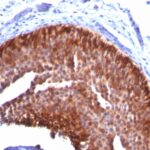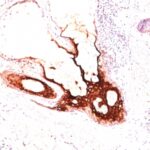Antibody (Suitable for clinical applications)
| Specification | Recommendation |
|---|---|
| Recommended Dilution (Conc) | 1:25-1:50 |
| Pretreatment | Citrate Buffer pH 6.0 |
| Incubation Parameters | 30 min at Room Temperature |
Prior to use, inspect vial for the presence of any precipitate or other unusual physical properties. These can indicate that the antibody has degraded and is no longer suitable for patient samples. Please run positive and negative controls simultaneously with all patient samples to account and control for errors in laboratory procedure. Use of methods or materials not recommended by enQuire Bio including change to dilution range and detection system should be routinely validated by the user.
Cytokeratin 17 Information for Pathologists
Summary:
Molecular weight of 48 kDa. Basal type cytokeratin (also 34betaE12, CK5/6, CK14) of complex epithelia but not in stratified or simple epithelia (Eur J Cell Biol 1992;59:127). Rapidly induced in wounded stratified epithelia (also CK 6, CK16); regulates cell growth through binding to the adaptor protein 14-3-3sigma (Nature 2006;441:362). Mutations cause pachyonychia congenita type 2 (J Dermatol 2006;33:161) or steatocystoma multiplex (Br J Dermatol 1998;139:475). Uses by pathologists
Common Uses By Pathologists:
Distinguish pancreatobiliary adenocarcinoma (CK17+) from extra-pancreatobiliary nonmucinous adenocarcinoma (CK17-, Am J Surg Pathol 2005;29:359). Distinguish cholangiocarcinoma (60% are CK17+) from hepatocellular carcinoma (CK17-, J Gastrointestin Liver Dis 2006;15:9). Distinguish renal urothelial carcinoma (CK5/CK6+, CK17+, vimentin-) from collecting duct carcinoma (CK5/CK6-, CK17-, vimentin+, Am J Surg Pathol 2005;29:747). Considered a marker of or associated with the basal phenotype (also CK 5/6, CK 14) of invasive or in situ ductal carcinoma of breast (Mod Pathol 2006;19:1506). Sensitive marker of sentinel nodal metastases by RT-PCR in oral squamous cell carcinoma (Clin Cancer Res 2006;12:2498).
| Cytokeratin 17 General Information | |
|---|---|
| Alternate Names | |
| Molecular Weight | |
| 48.1 kDa | |
| Chromosomal Location | |
| q21.2 [chr: 17] [chr_start: 41619441] [chr_end: 41624842] [strand: -1] | |
| Curated Database and Bioinformatic Data | |
| Gene Symbol | KRT17 |
| Entrez Gene ID | 3872 |
| RefSeq Protein Accession(s) | NP_000413 |
| RefSeq mRNA Accession(s) | ; NM_000422 |
| RefSeq Genomic Accession(s) | NG_008625; NG_009090; NC_000017 |
| UniProt ID(s) | Q04695 |
| PharmGKB ID(s) | PA30214 |
| KEGG Gene ID(s) | hsa:3872 |
| Associated Diseases (KEGG IDs) | Pachyonychia congenita 2 (PC2) [MIM:167210]: An autosomal dominant ectodermal dysplasia characterized by hypertrophic nail dystrophy resulting in onchyogryposis (thickening and increase in curvature of the nail), palmoplantar keratoderma and hyperhidrosis, follicular hyperkeratosis, multiple epidermal cysts, absent/sparse eyebrow and body hair, and by the presence of natal teeth. {ECO:0000269|PubMed:10571744, ECO:0000269|PubMed:11348474, ECO:0000269|PubMed:11874497, ECO:0000269|PubMed:11886499, ECO:0000269|PubMed:15102078, ECO:0000269|PubMed:15795125, ECO:0000269|PubMed:16250206, ECO:0000269|PubMed:16620218, ECO:0000269|PubMed:16625196, ECO:0000269|PubMed:17719747, ECO:0000269|PubMed:18547302, ECO:0000269|PubMed:19470054, ECO:0000269|PubMed:21326300, ECO:0000269|PubMed:23278621, ECO:0000269|PubMed:23855588, ECO:0000269|PubMed:7539673, ECO:0000269|PubMed:9008238, ECO:0000269|PubMed:9767294}. The disease is caused by mutations affecting the gene represented in this entry.; Steatocystoma multiplex (SM) [MIM:184500]: Disease characterized by round or oval cystic tumors widely distributed on the back, anterior trunk, arms, scrotum, and thighs. {ECO:0000269|PubMed:16620218, ECO:0000269|PubMed:9008238, ECO:0000269|PubMed:9767294}. The disease is caused by mutations affecting the gene represented in this entry.; KRT16 and KRT17 are coexpressed only in pathological situations such as metaplasias and carcinomas of the uterine cervix and in psoriasis vulgaris. |
| General Description of Cytokeratin 17 . | |
| This antibody is specific to 46 kDa cytokeratin protein designated cytokeratin 17. It reacts with basal cells in complex epithelia and reacts strongly with squamous cell carcinomas. | |








Reviews
There are no reviews yet.